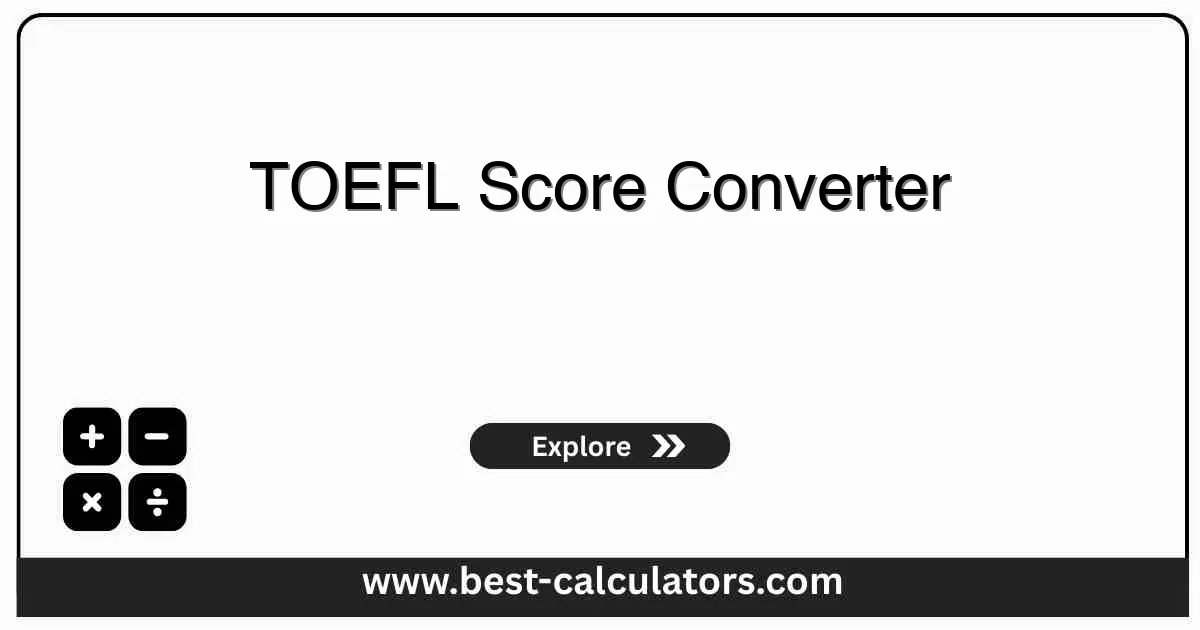TOEFL Score Converter - Convert TOEFL to CEFR, IELTS & Benchmarks
Instantly map your TOEFL iBT total score to CEFR levels, IELTS band ranges, and academic readiness benchmarks using structured, research-based equivalence.
TOEFL Score Converter
Conversion Results
Conversions are based on widely referenced mappings between TOEFL, CEFR, and IELTS. Always confirm minimum scores with official university, immigration, and scholarship requirements.
What is a TOEFL Score Converter?
A TOEFL Score Converter is a specialized education tool that helps you interpret your TOEFL iBT score across multiple standardized benchmarks. It estimates your CEFR level, IELTS band range, and English readiness for academic study using concordance-style mappings grounded in research and institutional practice.
Instead of guessing how a 72, 90, or 105 compares to requirements stated in CEFR or IELTS terms, this converter provides a consistent, monotonic interpretation that keeps higher TOEFL scores aligned with higher proficiency levels.
This calculator is especially useful for:
- University admissions planning - Compare your score against global entry requirements.
- Scholarship and visa screening - Check if your TOEFL aligns with minimum CEFR or IELTS thresholds.
- Test strategy decisions - Decide whether to retake TOEFL or consider IELTS instead.
To understand how your standardized test profile compares beyond language scores, check out our SAT Score to Percentile Calculator to see how SAT performance benchmarks align with competitive admission ranges.
For evaluating scholarships that combine English proficiency with academic results, explore our Scholarship Eligibility Calculator to estimate your chances for merit and need-based awards.
To verify that your grades support your language scores, use our College GPA Calculator to confirm your academic standing matches your English proficiency.
For long-term planning of study abroad expenses once your TOEFL score is on target, try our College Cost Calculator to model tuition, housing, and living costs accurately.
To project how current academic and test performance impact future returns on graduate study, use our Graduate School ROI Calculator to connect language readiness with long-term career value.
How the TOEFL Score Converter Works
The converter applies a piecewise mapping based on widely accepted TOEFL iBT to CEFR and IELTS equivalence ranges. It ensures monotonic behavior so higher TOEFL scores never map to lower proficiency levels.
Core reference bands (typical approximations):
- < 42 → A2 or below (Basic)
- 42–71 → B1 (Lower-Intermediate)
- 72–94 → B2 (Upper-Intermediate)
- 95–109 → C1 (Advanced)
- 110–120 → C2 (Highly proficient)
For each band, the tool assigns a sensible IELTS band range (for example, B2 ≈ 5.5–6.5, C1 ≈ 7.0–8.0) and qualitative readiness notes suitable for typical university thresholds.
Key Concepts: TOEFL, CEFR, and IELTS Alignment
TOEFL iBT Scale
TOEFL iBT is scored from 0–120, combining four sections (Reading, Listening, Speaking, Writing), each on a 0–30 scale.
CEFR Framework
CEFR levels (A1–C2) describe language proficiency from beginner to near-native and are widely used in admissions and visas.
IELTS Bands
IELTS uses 0–9 bands. Many universities specify minimum IELTS bands; our mapping helps compare your TOEFL score directly.
Equivalence, Not Identity
Mapped scores express comparable proficiency across tests, not identical formats or tasks. Use them as guidance only.
How to Use This Calculator
Enter TOEFL Total
Type your official TOEFL iBT total score between 0 and 120.
Add Sections (Optional)
Enter Reading, Listening, Speaking, and Writing scores for consistency checks.
Review Conversions
See CEFR level, IELTS band range, and readiness guidance instantly.
Plan Next Steps
Compare against target requirements and decide if a retest or alternative exam is needed.
Benefits of Using This Converter
- • Instant Interpretation: Convert TOEFL scores into clear CEFR and IELTS-style targets in one view.
- • Application Planning: Quickly check if your score is near typical university or visa thresholds.
- • Objective Benchmarks: Uses structured ranges instead of subjective guesses.
- • Section Awareness: Highlights unbalanced profiles that may need targeted improvement.
Factors That Affect Your Results
1. Institutional Policies
Universities may specify overall minimums, section minimums, or accepted test dates. Always check their exact rules.
2. Latest Official Guidance
Official concordance and policy documents can evolve. This tool follows stable patterns but cannot replace current official tables.
3. Program Selectivity
Competitive degrees (e.g., MBA, STEM, Law) often expect scores at the upper end of a band, even if minimums appear lower.

Frequently Asked Questions (FAQ)
Q: How does the TOEFL Score Converter work?
A: It uses structured concordance-style mappings built from ETS guidance and widely cited equivalence tables to estimate CEFR level, IELTS band range, and readiness indicators from your TOEFL total score.
Q: Is this conversion officially approved?
A: No. It is an informed approximation tool for planning. Only official TOEFL, IELTS, CEFR, and institutional sources define binding rules.
Q: Do universities accept converted scores instead of official reports?
A: No. You must submit official score reports. Use this tool only to interpret how your score compares to typical requirements.
Q: Why do some bands show a range instead of a single value?
A: Different institutions adopt slightly different cutoffs. Ranges reflect realistic intervals rather than a misleading single number.
Q: What if my section scores are unbalanced?
A: The converter flags large gaps because some programs require minimum section scores even if your total meets the threshold.
Q: Should I retake TOEFL based on this tool?
A: If your estimated level is below your target schools’ typical ranges or your sections are weak, a targeted retake can strengthen your profile.